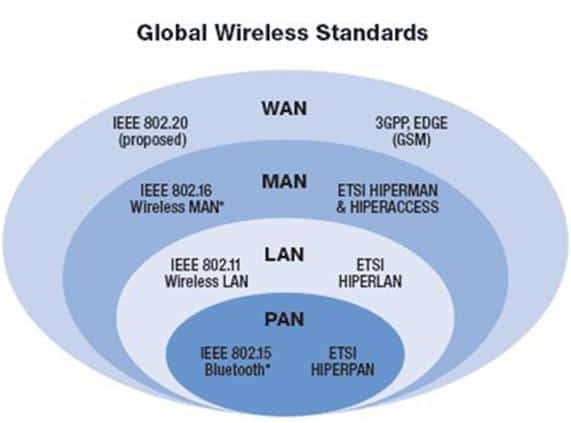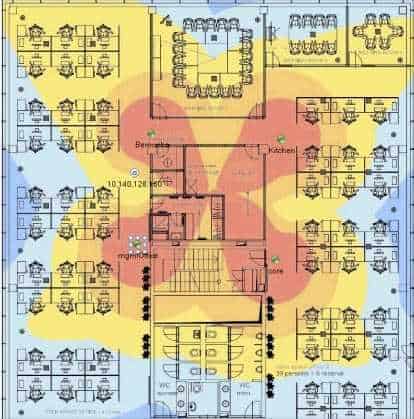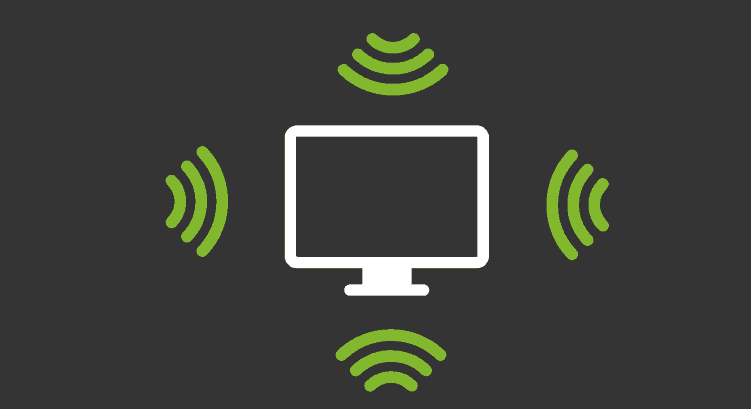Wireless Monitoring: Relevance and Tools
The concept “Wireless Monitoring” is quite broad. In fact, it covers all wirelessly instrumented communications platforms and the monitoring we can do on them.
We are talking about everything from the short-range signal of a Bluetooth device to sensors connected to a wide area wireless network.
In order to get an idea of all that it can cover, we will observe the following scheme:

Description Scheme with the standards associated with different wireless networks
In an article published in this blog we reviewed the challenges of LPWAN technology and its relationship with IoT.
Now, in this post we invite you to make a first approach to the issue of wireless monitoring.
Let’s start with a brief explanation: wireless local networks are often referred to by the trade name WIFI, or by the acronym WLAN, coming from Wireless Local Area Network. In this post, for simplicity’s sake, we will use “wireless networks” to refer to them.
Three factors that make wireless monitoring relevant
There are many reasons that make wireless monitoring a relevant topic:
- The presence of wireless networks on all corporate network platforms.
- The increase in the number and diversity of devices connected to wireless networks.
- The development of businesses in which wireless networks are the centrepieces of technology.
- The promotion of technologies based on wireless communications.
Here, we will talk about these three aspects:
Hotspots
Services accessed over a wireless connection have evolved; what was previously referred to as a simple Internet browsing service becomes more complex for both the user and the entity that manages the wireless network.
The different business models that are possible through the creation of so-called Hotspots and their captive portals demonstrate this.
Consider companies such as hotels, bookstores, cafeterias, shopping centers, convention centers; consider also organizations such as airports, libraries, parks, educational centers. All of them, by offering connectivity to a wireless network, aim to achieve objectives as diverse as:
- Complying with the provision of a service that users consider indispensable.
- Generating income from access permits.
- Allowing the connection of customers with the idea of evaluating their behaviour.
- Having a relatively inexpensive means of promoting products and services.
Particular support requirements
It is easy to understand that the contingent of users connecting to wireless networks has very specific requirements for the support group.
In this sense, the results presented by the company ZK Research are interesting, after surveying in 2017 those responsible for the communications platforms of one hundred North American companies, with more than one thousand employees each:
- 47% indicated that at least 10% of their users report weekly problems with their wireless connections.
- 60% of respondents said that they spend more than 25% of their operating time identifying and diagnosing problems associated with wireless networks.
- 69% said that the process of identifying and diagnosing problems on wireless networks is greater than the time spent solving those problems.
You can review the analysis by Zeus Kerravala, director of ZK, here.
The new 802.11ax standard
The ratification of the new IEEE 802.11ax standard is expected by 2019, which must technically surpass current standards, offering the ideal platform for an increase in the number of connections and applications with high bandwidth consumption.
Indeed, the 802.11ax standard promises speeds of 4.8 Gbps, which represents a substantial increase in the speed offered by the 802.11ac standard. Increase sustained by the introduction of a higher density modulation scheme: 1024QAM (Quadrature Amplitude Modulation), higher than the current 256QAM.
Another interesting promise is undoubtedly the greater stability and efficiency. In order to do this, the new standard offers the incorporation of access technologies based on OFDMA (Orthogonal Frequency Division Multiple Access), which will allow simultaneous access by multiple users based on upward and downward links.
You can check the technical aspects of the 802.11ax standard in this document produced by Cisco.
However, experts in wireless network design and maintenance receive news of this new standard with the normal quotas of skepticism, with the problems they have already faced in the implementation of standards in the past: compatibility and migration.
Base wireless networks can count on old customers, equipped for speeds in terms of Mbps, asking valid questions about what is the ideal current situation to undertake a migration, whether the current equipment is compatible and what real impact the new additions will have.
It is fair to think then that these three factors: Hotspot, support needs and the upcoming incorporation of a new standard clearly reinforce the need for a wireless network monitoring scheme that is the firm step to face the immediate challenges and establish a migration process to 802.11ax without too many final frustrations.
Wireless Monitoring
Wireless monitoring processes have changed over time. Beyond the technical improvements it is important to note that the objective has changed.
Thus, we have moved from a more inventory-oriented interest (networks, users, channels) to a more user-oriented interest in evaluating and optimizing the user experience (user characteristics, what networks and channels they use, the speed they have, what applications they use and the performance).
As the objectives have changed, so have the technical tests that are considered basic in a wireless monitoring scheme. We invite you to take a look at them below.
Testing with Wifi Analyzers
These tests are performed based on tools that can be downloaded to devices such as tablets or laptops, and must provide an overview of the wireless environment that users can work with.
The most basic tools focus on detecting the available networks and offering, in a simple scheme to understand, the identification and coverage of each one of them.
The most sophisticated tools can present more technical information about the different access points, such as their identification, brand or manufacturer, channel used and speed.
Wireless Site Survey
A wireless site survey is a test used both in the design phase and in the management phase.
In the design phase, it attempts to establish the viability of implementing a wireless network in the given geographical area and seeks to facilitate the choice of the best location for access points, in order to avoid overlaps and interference.
In the management phase, these tests are intended, given a geographical area to be evaluated, to establish objectively the access points, the own or external networks and the level of the signals presented by each network.
Spectrum analysis and the search for noise sources
The idea of these tests is to determine if there are emissions that do not correspond to a valid wireless source. Sources that, by introducing noise, can affect our communications.
Noise generating elements include wireless surveillance cameras, iBeacons (Apple positioning system), ZigBees (low power consumption wireless devices, regularly associated with industrial automation and domotics), WiFi inhibitors, and even equipment such as microwaves.
Eliminating these noise sources can reduce the number of forwarded packets, improving signal quality and overall network performance.
Coverage Maps
HeatMaps are graphical representations that allow the visualization of data from wireless site survey tests and spectrum analysis.
A coverage map takes the range of wireless network access point signals and the effect of noise, and superimposes this information on a map of the area or areas in question.
This facilitates the determination of areas without coverage, those where coverage is best, the volume of users, the location of these users and whether or not it is necessary to relocate some of the hardware elements.

Coverage map
Testing from users
These tests aim to provide real-time information and historical data on network availability and performance from a user perspective.
They are usually implemented through sensor equipment that, located in the user’s environment, offer data such as signal quality, information sent and received, number of lost packets, and even offer information on the performance of the applications accessed.
Tools for Wireless Monitoring
Having reviewed the basic tests, it is appropriate to pay attention to the recommendation that most wireless network specialists insist on:
“It is important to have a set of tools that allow us to establish a solid monitoring and management scheme for our wireless networks.”
However, the task of choosing these tools is not necessarily straightforward, since the market offers multiple monitoring and management tools, which differ greatly in what corresponds to their scope.
Thus, we find Identification Monitors, Wireless Protocol Analyzers, Spectrum Analyzers, Mapping Tools, Sensors, etc., which at the end of the day are different implementations of the tests described in the previous section.
This is why we recommend as the best starting point a general purpose-monitoring tool, like Pandora FMS.
Whether you already use Pandora FMS or you are evaluating the product, the idea of defining monitoring precepts that work for all critical areas of your business, from wired local networks to applications, passing through wireless networks, will surely have important technical and economic benefits.
For example, in a very short time, information about devices, such as wireless routers and access points, could be recorded via the SNMP protocol, as is done with other network elements in the wired environment, such as switches and routers.
From there, the flexibility of the tool, its visualization capabilities, compatibility with protocols such as NetFlow, the possibilities of integration with other devices and the automation of tasks can be very useful to generate the monitoring scheme of wireless networks, functional for the current situation and that scales well for the future.
Of course, we invite you to review the facilities offered by Pandora FMS in this link, and share your experiences in the subject of wireless monitoring.





















